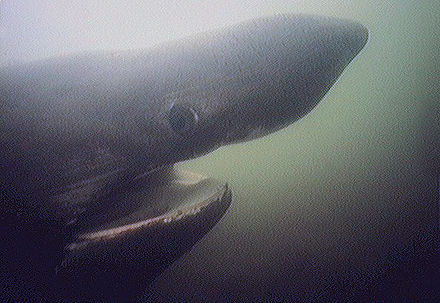Basking shark
The basking shark (Cetorhinus maximus) is the second-largest living shark and fish,[4] after the whale shark, and one of three plankton-eating shark species, along with the whale shark and megamouth shark. Adults typically reach 7.9 m (26 ft) in length. It is usually greyish-brown, with mottled skin. The caudal fin has a strong lateral keel and a crescent shape.
The basking shark is a cosmopolitan migratory species, found in all the world's temperate oceans. A slow-moving filter feeder, its common name derives from its habit of feeding at the surface, appearing to be basking in the warmer water there. It has anatomical adaptations for filter-feeding, such as a greatly enlarged mouth and highly developed gill rakers. Its snout is conical and the gill slits extend around the top and bottom of its head. The gill rakers, dark and bristle-like, are used to catch plankton as water filters through the mouth and over the gills. The teeth are numerous and very small, and often number 100 per row. The teeth have a single conical cusp, are curved backwards and are the same on both the upper and lower jaws. This species has the smallest weight-for-weight brain size of any shark, reflecting its relatively passive lifestyle.[5]
Basking sharks have been shown from satellite tracking to overwinter in both continental shelf (less than 200 m or 660 ft) and deeper waters.[6] They may be found in either small shoals or alone. Despite their large size and threatening appearance, basking sharks are not aggressive and are harmless to humans.
The basking shark has long been a commercially important fish as a source of food, shark fin, animal feed, and shark liver oil. Overexploitation has reduced its populations to the point where some have disappeared and others need protection.[7]
The basking shark is the only extant member of the family Cetorhinidae, part of the mackerel shark order Lamniformes. Johan Ernst Gunnerus first described the species as Cetorhinus maximus, from a specimen found in Norway, naming it. The genus name Cetorhinus comes from the Greek ketos, meaning "marine monster" or "whale", and rhinos, meaning "nose". The species name maximus is from Latin and means "greatest". Following its initial description, more attempts at naming included: Squalus isodus, in 1819 by Italian Zoologist Saverio Macri (1754–1848); Squalus elephas, by Charles Alexandre Lesueur in 1822; Squalus rashleighanus, by Jonathan Couch in 1838; Squalus cetaceus, by Laurens Theodorus Gronovius in 1854; Cetorhinus blainvillei by the Portuguese biologist Felix Antonio de Brito Capello (1828–1879) in 1869; Selachus pennantii, by Charles John Cornish in 1885; Cetorhinus maximus infanuncula, by the Dutch Zoologists Antonius Boudewijn Deinse (1885–1965) and Marcus Jan Adriani (1929–1995) in 1953; and Cetorhinus maximus normani, by Siccardi in 1961.[8] Other common names include bone shark, elephant shark, sail-fish, and sun-fish. In Orkney, it is commonly known as hoe-mother (sometimes contracted to homer), meaning "the mother of the pickled dog-fish".[9]
The oldest known members of Cetorhinidae are members of the extinct genus Keasius, from middle Eocene of Antarctica, the Eocene of Oregon and possibly the Eocene of Russia. Members of the modern genus Cetorhinus appear during the Miocene, with members of the modern species appearing during the Late Miocene. The association of Pseudocetorhinus from the Late Triassic of Europe with Cetorhinidae is doubtful.[10]




